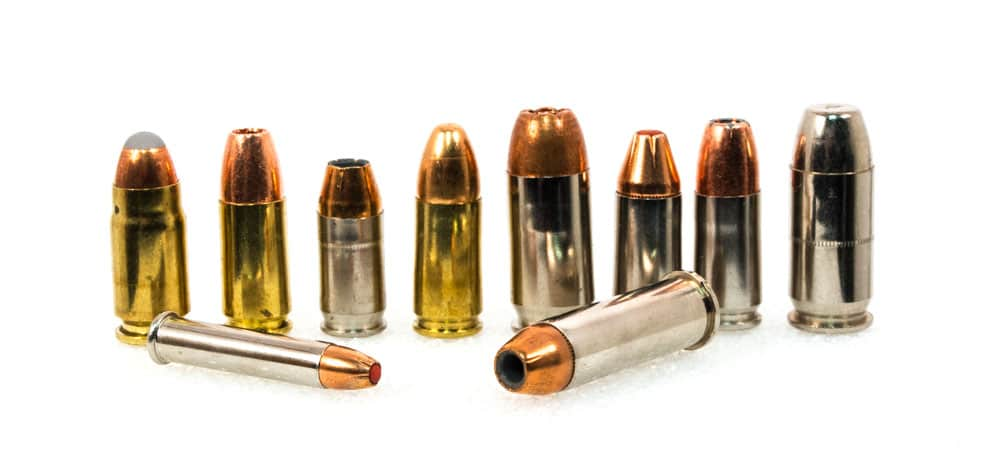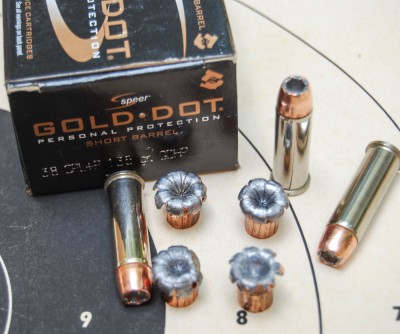Ten Top Self-defense Ammo Picks
Tom McHale 07.08.14

With a controversial topic like the best self-defense ammo out there, I have to include a couple of explanations and disclaimers.
You have to be careful about blanket statements when it comes to ammo performance. There are just too many variables. For example, you can’t necessarily say things like “Mega Blaster Yellow Tips” are the best. You might be able to say “Mega Blaster Yellow Tips 9x19mm 124-grain +P loads are the best!” It may very well be the case that the .40 Smith & Wesson loading of Mega Blaster is not so hot, but maybe the .45 ACP, 9x19mm, and .380 ACP loads are. You always have to look at the specifics like caliber, bullet weight, and gun type. In other words, you need to make sure the specific brand of self-defense ammo you choose works in your caliber and in your gun. Some offerings, like a few mentioned here, recognize caliber variables and design accordingly. For example, DoubleTap Ammunition varies projectile types to account for such factors.
Velocity is a really big deal and performance statements always have to be qualified with variables that impact velocity. While a specific .45 ACP ammo self-defense cartridge may work as expected every time from a gun with a four- or five-inch barrel, it may not work at all with that micro-compact 1911 with a one-inch barrel. Okay, I’m exaggerating, but in my testing, I’ve found that even a 50 to 100 feet per second velocity reduction from a cartridge’s use in a short barrel can make a great bullet stinky and inconsistent.
With that said, expansion (or perhaps fragmentation) performance weighed heavily in the development of this list. After all, self- and home-defense ammo is intended to stop things quickly.
I’m blending self defense (concealed carry) and home defense on this list. Just because I feel like it. With that said, let’s get busy.
DoubleTap Defense
I’ve spent a lot of time with Mike McNett, the godfather of boom, and know what he puts into ammo development and testing. In fact, I’m pretty sure that Mike buys up 84 percent of the annual worldwide production of gelatin blocks.
DoubleTap makes a variety of ammo types for various purposes, but for this list, stick to the DoubleTap Defense and DoubleTap Tactical lines. These loads, available in nearly any caliber you want, use either the excellent Barnes TAC all-copper bullets or bonded projectiles, depending on the specific load requirements. Like 1911s? Check out the Mann Load. It uses a 160-grain Barnes TAC bullet moving at over 1,000 feet per second and has great expansion and penetration, but low blast and recoil. If you carry a .380 ACP, consider the 90-grain Bonded Defense offering.
They’re not cheap, but they work.

Speer Gold Dot Short Barrel
The plethora of compact revolvers and semiautomatics available today sent the Speer engineers back to the drawing board. Speer Gold Dot ammunition has always been one of my favorite performers in almost any caliber. But, like any ammo, it’s designed with a careful balance of expansion and penetration assuming a specific velocity range. When you fire ammo from a gun with a short barrel, say three inches or less, you’re likely to lose as much as 100 feet per second (or more) in velocity. Then that carefully-planned balance goes out the window. If you suffer from a short barrel, make sure you use ammo designed for lower velocity.
.223/5.56x45mm Practice Ammo
Well, sort of. For a home-defense scenario, standard, full metal jacket 5.56 ammo is a pretty darn good option. Here’s why. When using any ammunition “indoors,” over-penetration is a potentially serious issue. Pistol rounds, shotgun slugs, and buckshot go through walls like tax evaders through Congress. So do many hunting and tactical .223 and 5.56 projectiles—they’re designed to do that.
On the other hand, small, lightweight, standard full metal jacket 55-grain projectiles tend to fragment and start upsetting when they hit things like drywall. Counter to assumption and common sense, AR-15-type rifles may present less of an over-penetration risk than a .38 Special. It’s something to consider for home defense, especially since most guns that use this ammo have 30-round magazines.

Federal Guard Dog .45 ACP
I tested Federal Guard Dog a while back in its .45 ACP configuration and found it surprisingly functional.
It’s an expanding full metal jacket design, and yes, you heard that oxymoron correctly. It has at least three potential use-cases. Some locales prohibit standard hollow point expanding ammunition. Technically, this design is not a hollow point, so it just might defeat those silly and pointless laws. Second, it expands reliably after passing through barriers like heavy clothing as there is no hollow point to clog up. Third, the expansion also helps reduce over-penetration when it hits something like an interior wall.
For self or home defense, here’s another thing I like about it. It’s a standard-pressure round with a lighter-than-normal projectile for each caliber, so recoil and muzzle blast are very, very tame. For example, the .45 ACP offering uses a 165-grain bullet rather than the standard 185-, 200-, or 230-grain bullets. I found recoil to be shockingly mild and expansion was, well, awesome.
Hornady Critical anything
Hornady makes a number of critical things—Critical Defense and Critical Duty, for starters. The bullets share some common features like a design that expands in pretty much any situation. They are hollow point jacketed bullets, but the points are filled with a red polymer plug that aids expansion when the bullet impacts something. This mostly eliminates the problem of “clogged” hollow points acting like full metal jacket bullets and not expanding.

I got bored some time ago and did a whole series of testing with Hornady Critical Defense and Critical Duty ammo. Hornady claimed that it “always expands” so I had to put that to the test. I shot it through all sorts of realistic and ridiculous barriers to see if it would expand. things like flour, wood, leather, The New York Times, and Spam. At one point, I even shot it through rocks. Well, technically they were stone floor tiles. Nonetheless, the projectiles still expanded.
Testing nearly a dozen varieties and calibers, I found the following. Some projectile brands will expand dramatically under ideal conditions, but fail under less than ideal conditions. Hornady Critical Defense and Critical Duty will expand less dramatically, but very well, under nearly any condition. If you want something reliable that will work in many different scenarios, take a look at Hornady’s offerings.
.357 SIG almost anything
If you push a marshmallow fast enough, it could blow up (okay, maybe seriously damage) a tank. .357 SIG fires a 9mm bullet anywhere from 1,300 to 1,600 feet per second. Most hollow point bullets can’t help but expand when moving that fast—barriers or no barriers.
Of particular interest, check out the CorBon 125-grain DPX load. I tested this one through two layers of heavy boot leather and multiple layers of fabric and the solid copper projectiles still expanded beautifully.
One drawback is the muzzle blast and recoil. It’s snappy.
Just as a side note, if you shoot a .357 SIG hollow point at a huge glass jar of grape jelly, it will vaporize.

Speer Gold Dot
I mentioned the Short Barrel version separately as it’s worthy of its own look. I’ve had excellent results with a wide variety of standard Speer Gold Dot ammunition. The bonded design ensures that the bullet and its cover stay together, even through barriers. Loads that have performed exceptionally well include the 9mm Luger +P 124-grain, the .357 SIG 125-grain, .45 ACP +P 200-grain, and .40 S&W 155-grain. I’ve also had good success with the .38 Special +P 135-grain standard load, not to be confused with the Short Barrel version.
Winchester Train and Defend 9x19mm and .40 S&W
Here’s a new kid on the block that I’ve been testing. Some of the self-defense ammo types on this list are mega blasters. They sport big velocity and corresponding big performance and big noise and recoil. Winchester’s Train and Defend line goes the other way. The design parameters for the Defend line call for performance in realistic self-defense environments and provide benefits to the shooter as a result. It’s not supposed to pass through 14 car windshields and expand to 17 times its original diameter. It is supposed to offer low blast and low recoil and expand after passing through normal clothing barriers, and that it does. The best part, especially for newer shooters, is that the Train ammo for each Defend load “feels” the same to shoot, but uses cheaper full metal jack bullets. Practice with those, then load up the Defend ammo when you get home from the range. Great idea and simplicity at its best.
Winchester also makes Train and Defend in .380 ACP and .38 Special. I only don’t list those here as I’ve not had the opportunity to test them yet.
I should also mention Winchester’s PDX1 Defender line. So far, I’ve tested the 9x19mm offering and 165-grain .40 S&W with great results. PDX1 projectiles are bonded and keep all of their original weight intact.

Remington Golden Saber .45 ACP +P 185-grain
Here’s one that I currently carry in 1911s. The lighter bullet and +P boost give bring it to 1,165 feet per second out of my Springfield Armory TRP. Expansion and penetration have proven to be excellent, even after passing through tough barriers like leather and fabric.
Buffalo Bore 9mm +P+ 95-grain Barnes TAC-XP
Here’s an unusual one that turned in an impressive performance. Using a light-for-caliber 95-grain solid copper Barnes TAC-XP bullet, this cartridge delivers big-time velocity with surprisingly low recoil. From a few of my test guns, I clocked the following:
- Beretta 92FS: 1,420 feet per second
- Glock 17 Gen 4: 1,438 feet per second
- Glock 26 Gen 4: 1,358 feet per second
These are a few of the ammo choices that have floated to the top of my list based on some pretty intensive, and sometimes silly, testing.
What do you keep in your carry and home-defense guns?
Tom McHale is the author of the Insanely Practical Guides book series that guides new and experienced shooters alike in a fun, approachable, and practical way. His books are available in print and eBook format on Amazon.
Note added 7/9/2014: This article has been edited to correct an error regarding .357 SIG. Due to an editing mishap, the text originally stated that the cartridge uses a “9x19mm” projectile. The text has been corrected to state that the cartridge uses a 9mm bullet.

